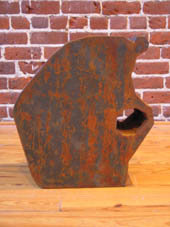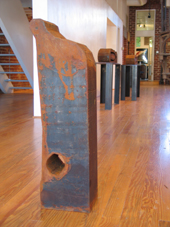|
December 2004/January 2005
|
|
|
|
|
Reviews
Tom Bills at b. sakata garo
By David Roth, a contributing editor to Artweek
 |
Tom Bills, Ester, 2004, flame-cut slab, 17"x16"x7 1/2, at b. sakata garo, Sacramento
|
| |
|
I'll confess: Going into this show I knew a lot more about Tom Bills than I did about his work, and that information carried some weighty expectations. Namely, that Bill's eight-year stint as Richard Serra's studio assistant would make for super-sized sculptures with ambitions to match. Bills's steel sculptures are monumental, but only in impact--not size or scale.
A Detroit native who spent twenty-five years in New York before joining the UC Davis art faculty, Bills has plenty of noteworthy large-scale sculptures to his credit, both here and abroad. However, his output over the past twenty years consisted primarily of compact structures: 500 - to 1,000-pound, flame-cut slabs that reference figurative and natural elements, often in a single piece. Stationed on the floor or on pedestals, the fourteen works seen here stand waist-or knee-high and require viewers to sit to fully appreciate them. What they reveal are a masterful manipulation of weight, scale, texture, volume and space that add up to a unique vision.
Bills's strong suits are his ability to seamlessly integrate opposites and conduct extended improvisions around a theme. Here, the reoccurring motif is a twelve-sided, see-through polygon wedded to an irregularly shaped mass rendered in either rust or a highly polished finish.
A prime example of the latter is Monkey See, a title that probably refers to the ovoid through which viewers can spy whatever resides in the background. (In this case it's the gallery's outdoor garden.) Buffed to a high gloss, the piece pulls viewers several ways at once. Reflections from the polished surface pulsate like electrical currents from an indeterminate depth and speak of high technology, while the piece's ragged edges whisper funk a la Fred Flintstone. Reconciling those extremes keeps the eye and the brain busy.
Other successful variations on this theme include Lucky Day and Carry that Weight (for VZ), where a reclining figure cartoonishly balances an outsized load. Such dialogues between mass and volume yield shapes that recall Jean Arp, Isamu Noguchi and Alexander Archipenko, and work well because they integrate simple, organic, curvilinear forms into stolid shapes that might otherwise feel inert and flat. That integration prevails throughout the show.
Backbone and Whale Sighting , for example, sit side-by-side and work in tandem, simultaneously suggesting the outlines of a whale enveloping a sexually aroused figure in a yoga pose. Rusted to a ferrous earthy red, they carry less fanfare than the polished pieces, but they still challenge viewers to separate abstract forms from representational images.
Elsewhere, Bills seems to be influenced by southwestern landscapes. Cowboy Dreams , for example, suggest the texture and tone of Utah's redrock monoliths, replete with "windows" in the rock and Rothko-like washes. The same holds for the shiny Smoke Sisters, which even in its polished condition, recalls Monument Valley and Eastern Oregon, a volcanic region that just so happens to have a chain of peaks known as Three Sisters.
Suspending the gravitas normally associated with steel is no easy feat. Bills pulls it off effortlessly with The Eye of a Wing. It's a straightforward representation of an airplane wing punctuated by a hole in the center which imparts the palpable sense that the object could just as easily float into the sky as stand still. The experience is akin to witnessing the landing of the normally peripatetic hummingbird.
The only disappointment in the show is The Three of Us , a rusted piece that resembles a large tuning fork. For the most part, Bills uses straight lines sparingly and to good effect, as in Backbone, Whale Sighting and Cowboy Dreams. But, in The Three of Us they foreclose the possibility of vibration at a point where it ought to be given full throttle. A small quibble in an otherwise strong show.
Tom Bills: New Work closed in October at b. sakata garo, Sacramento.
|
|
Art in America
Tom Bills at b. sakata garo
By Lilly Wei
 |
Tom Bills, Cowboy Dreams 2004, flame-cut slab, 32 1/2"x10"x7 1/2, at b. sakata garo, Sacramento
|
| |
|
The sculptures Tom Bills showed here were substantially smaller than his usual fare. All new, the 14 works included are approximately 2 to 3 feet hight and insistently frontal--meaning in this instance that they can be viewed from front or back but are functionally two-dimensional, offering no real side view. They were all done in steel, his signature medium, which he cuts with an acetylence torch in a process he likens to carving stone. Bills sees little difference between a slab of steel and a block of stone and considers the flame a shaping tool that releases the figure.
Many of the works are, as usual, rich in flaking patches of rust, but, in a departure for the artist, several are also highly polished. In these, the light interacts with the brushy, expressionist patterns on the surface--the residuum of the process--and mass, touched and retouched, dissolves in its own sheen, becoming more buoyant. Bills has taken minimalist-style sculpture and toned down its toughness and intransigence without losing immediacy or force. His shapes, intuitively derived, can be as forceful as those of his Minimalist predecessors, but they are also more vulnerable, their formality jostled by a self-dprecating humor. These chunky small fry, placed on the floor and on pedestals--lower than eye level--combine modernist geometry with referential abstraction. For instance, Ester, Edsel and Cowboy Dreams--solid, sturdy floor pieces--might suggest feisty figures, tongue-in-check monuments to anti-heroes, or the triumph of the little guy.
In another departure from Bill's usual practice, almost every work here encompasses a void of some kind, so that the authority of steel is violated and the interior of the sculpture revealed, from the fist-size hole in Ester to the openness of the silvery Monkey See , which is almost all oval-rimmed space, like a mirror frame with the looking glass removed. This last configuration is repeated in Lucky Day and Carry That Weight, but in all three works Bills resists the fluidity of the classic oval, preferring to leave the contours rough, as cut by the acetylene torch, rather than completely smoothed. The effect is to slow down the eye as it travels the curve. Carry That Weight could just as well served as the title for this show and its cast of heavy objects leavened only by the introduction of space.
Other works in the exhibition appeared more landscape-oriented, such as Whale Sighting or Backbone, both of which are horizontal. Cut through, their mass is punctured in both cases by an extended sliver of curvilinear space that suggests a drawing. Another hoizontal work is the handsome Eye of a Wing , with its central oval-shaped void, balanced on either side by matching oval solids. Bills's sculptures are strikingly self-sufficient, still based squarely on mass, space and material rather than on the niceties of installation or context. Laconic, deceptively unassuming and structurally clear, these works have a straightforward factuality that ultimately carries the weight of their conviction.
|
| |